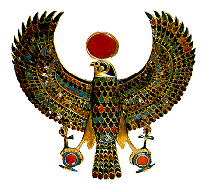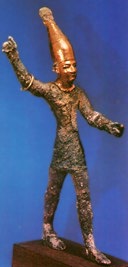|
|
|
Part III: Sacred Knights,
Holy Architects and Egypt |
|

|
The European Enlightenment: The more modern origins
of Black fraternities and sororities and their African link begins oddly
enough in Europe. Though it is the height of the African slave trade and
probably the most downtrodden period for many Africans, it is also the
period of the European Enlightenment. A philosophy espousing knowledge
to uplift the individual as well as society, the Enlightenment boasted
such figures as Newton, Voltaire, Rosseau and Hume. Of particular
interest is that nearly every important figure of the European
Enlightenment, particularly in France where the Enlightenment reaches
its greatest heights, was a member of freemasonry. What is important for
this discussion is that they all saw none other than ancient Egypt as
the very repository of divine knowledge or Enlightenment. This
fascination with Egypt of course did not entail a fascination with
Blacks. It should be said that these figures were notorious racists. In
fact to remedy the paradox of holding a fascination with the very land
whose people were held under the yoke of slavery, Africans were removed
from Egypt and Nubia altogether. But the purpose of this work is not to
discuss the politics of the time, but rather the philosophy. So the
question to be asked is why? Why would European members of the
Enlightenment, many of them freemasons, hold such a fascination and
reverence for Egypt? The answer is a complex one which this work hopes
to condense below. And it begins with none other than geometry.
|

|
During the Middle Ages there arose a Christian order of
warrior monks known as the Knights Templar. Much has been written of the
Templars: their involvement in the Crusades, their overwhelming power
(real or imaginary), accusations of occultism and of the mystery of
their disappearance. Whatever the actual truth concerning the Templars,
a great deal of Enlightenment masons in Europe traced descent, either
directly or indirectly, to the Knights Templar. Why? Well a great deal
of it may have to do with geometry, or more aptly put, "sacred
geometry." This is the notion that certain geometric properties hold
sacred or divine qualities. Thus buildings may be built to a certain
geometric precision, to face certain directions, etc. The Knights
Templar were believed to be famous for this. Many cathedrals in Europe
bearing such sacred geometry have been attributed to them. Whether they
actually built them is unimportant to this discussion; what is important
is that Enlightenment masons of Europe believed so. Pictured above is a
seal of the legendary and mysterious Knights Templar. But why would
these Enlightenment figures connect the Templars with Egypt? That takes
us even back before the Templars existed: to tales of Hebrew kings,
temples and Phoenician architects.
|

|
King Solomon's Temple is probably one of the most
important symbols in freemasonry. One of the reasons for its importance
is the reputed elements of sacred geometry which permeate the temple.
The geometric precision which allowed the temple to permit only certain
amounts of light in at certain times of the day earned it a famed
reputation. It was believed by many that the Knights Templar were trying
to emulate this very type of sacred geometry in their Christian
structures. But many Enlightenment freemasons may have known that the
Hebrew temple of King Solomon was not built by Hebrews. In fact it was
built by none other than Phoenicians. And with the Phoenicians, we get a
little closer to the puzzle. The Phoenician builder reputed to be in
charge of the building of King Solomon's Temple is Hiram Abiff. Hiram
Abiff's attention to sacred geometry would have come about as a result
of Phoenician and not Hebrew deities and beliefs. And here is where we
have the link, for many a Phoenician deity can be traced back to Egypt.
Following the expulsion of the Asiatic Hyksos invaders, Egypt becomes
for the first time a type of Empire. And she conquers in the direction
of the origin of her one time invaders, towards Western Asia and
Phoenicia. There are reports of Egyptian rulers capturing and bringing
back Phoenician princes to indoctrinate them in Egyptian beliefs so as
to make vassals of their kingdoms. The Phoenicians become very
acquainted with a host of Egyptian gods who either blend in or at times
even supplant their own. Pictured above is the Phoenician deity Baal. His
demeanor and headdress are specifically Egyptian. Thus Hiram Abiff's
deities and particular ceremonial rituals to sacred geometry and
architecture would not have been Hebrew or truly Phoenician, but rather
of Egyptian origin. |

|
It is not hard to see now why the Enlightenment masons would
have linked Egypt to sacred geometry and thus divine knowledge.
Following this link from the Knights Templar to Solomon's Temple and
Hiram Abiff to Phoenician deities and eventually ending up in Egypt is a
continuous course. In fact some have questioned if Hiram Abiff may have
been based, partially or completely, on an Egyptian architect of sacred
abilities known as Imhotep. Imhotep was the royal advisor to King Zoser
during the 3rd Dynasty of Egypt. Regarded as the world's first recorded
multi-genius, Imhotep was an architect, astronomer, philosopher, poet
and physician. As an architect he was responsible for designing the Step
Pyramid and the Saqqara Complex. During his lifetime he was given a host
of titles, among them:Chancellor of the King of Lower Egypt, the
First after the King of Upper Egypt, High Priest of Heliopolis and
Administrator of the Great Palace. As a physician, Imhotep is
believed to have been the author of the Edwin Smith Papyrus in
which more than 90 anatomical terms and 48 injuries are described. This
is well over 2,200 years before the Western Father of Medicine
Hippocrates is born. Some 2,000 years after his death, Imhotep was
deified by the inhabitants of Egypt and was known later as
Asclepius, God of Medicine, to the Greeks. His very name,
"Im-Hotep", translates as the Prince of Peace. As a philosopher
and poet, Imhotep's most remembered phrase is: "Eat, drink, and be merry
for tomorrow we shall die." The great African Egyptian architect Imhotep
would have been linked immediately with principles such as sacred
geometry. It is quite probable that if a figure such as Hiram Abiff did
exist, he may have worshipped Imhotep as a god of architecture. And if
he did not worship Imhotep directly, he may have worshipped him
indirectly in the form of some Imhotep based Phoenician or Greek
architectural deity. But in truth the entire notion of sacred geometry
existed even before Imhotep, in the very African gods he himself
worshipped. |

|
As already stated Ausar (Osiris) was the god king who was
killed and raised from the dead again. This ritual of being raised from
the dead is a key facet of freemasonry and many other secret societies.
And such rituals would have been practiced during Imhotep's time and
much later during Hiram Abiff's time. These rituals of being raised from
the dead symbolized Ausar's triumph over not just physical death but
mental death as well. Thus it was a triumph over ignorance and victory
for divine knowledge. And as it was written in Egypt, "ignorance is
evil," it would have symbolized a triumph over destructive evil forces
as well. Nearly all secret societies thus speak of one dying (mentally)
and being reborn with new knowledge. But more important than Ausar and
his ritual of resurrection would have been most probably the most
important deity in Egypt. |


|
Ptah in Egypt was one of the earliest gods of Creation. Ptah
was sometimes none other than the great hill which rose from the waters
of Creation. He was called the "Father of the Gods." And more
importantly to these discussions, he was "The Keeper of Sacred
Geometry," "Grand Master Architect" and "Creator of the Universe." And
with Egypt's vast dedication to sacred geometry in its temples and
pyramids, one can see that Ptah was probably the most revered god of
all. Pictured above are two depictions of the god Ptah. The picture on
the right is Ptah in the geometric "Magic 3-4-5" position. What is
displayed here is none other than the famed geometric theorem identified
with Pythagoras. This theorem was known in Egypt for several thousand
years before the birth of the Greek mathematician to whom it is
erroneously attributed. |
|
It is no wonder the freemasons of Enlightenment Europe saw a
connection with Egypt to their ideas of sacred geometry. To the
historically acquainted the trail back to Egypt was not so difficult to
notice. And once one did find their way back to Egypt the vast amounts
of architecture boasting sacred geometry, the concealed "Mysteries,"
secret societies, etc. was difficult not to notice. Thus Egypt became
the great repository in their minds of ancient knowledge, the most
divine knowledge of mankind originating in the heart of Africa itself.
But as stated before this was not a great time for Africa and her
descendants. And thus though the Africans' ancient achievements were
celebrated, he/she would be removed from the picture. And the Egyptians
and even Nubians would be reclassified as "dark whites," "Eurafricans"
or other such names. But fortunately enough, not every bit of light was
blocked from the African mind. And some Africans began to surprisingly
find themselves staring at Africa in places they would have never
suspected. |
Written by Bro. Dexter Gabriel. Copyright Mu Nu
Chapter 2000. All rights reserved. Except as provided under U.S. copyright
law, all written information may not be reproduced, resold, distributed or
modified without the express permission the Mu Nu Chapter.
Pictures & Information Courtesy of
Black Athena
Vols. I & II by Martin Bernal
Nile Valley Contributions to
Civilization by Anthony T. Browder
Black Spark, White Fire by
Michael Poe
Man, God and Civilization by John G. Jackson and the
Africana Studies
Research Page
|
|
|
|
| |
Online
Poll
|
|
Online
Poll
Quote of the Week
Quiz Question
|
| Advertisements
|
|
|
|
|
|
|